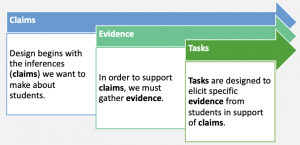Overview
The CenterPoint Mathematics Diagnostic Screeners consist of 9 assessments, one at each grade/course, Grades 1 – 8 and Algebra 1, that each focus on the Priority Standards as identified by Student Achievement Partners. The purpose of the Screeners is to determine student’s proficiency of skills and understandings of the most critical content from the previous grade to inform next steps in helping students gain proficiency of this critical content.
As an example, a primary use case is for 4th grade students at the beginning of the school year to take the Grade 4 Screener which assesses the most important content in grade 3. This gives critical information to teachers about skills and understandings where students may need support prior to or in conjunction with learning 4th grade content.
Each screener has a maximum of 30 questions so that testing time is minimal while still providing sufficient data about student strengths and areas of need in the most critical content areas. The screeners use traditional item types, e.g., multiple choice, as well as technology-enhanced items, e.g., drag and drop. CenterPoint utilizes item types that provide the best way for students to show the evidence of learning that is desired. All items are computer-scored, which provides immediate results allowing for educators to promptly consider next steps in learning.
Evidence Centered Design
CenterPoint uses evidence centered design to help to ensure the screeners provide quality data that can be used to make informed decisions. The design of the screeners begins with inferences, or claims we want to make about student proficiency. To support those claims, we must gather evidence from tasks that are designed to elicit specific evidence in support of the claims.

Claims
The CenterPoint Screeners were designed to provide information on the priority standards for the overall grade, at the cluster level, and in some cases, at the standard level.
Evidence and Tasks
Each question or task on the screeners was designed so that students could demonstrate evidence of learning to support the claims. Additionally, CenterPoint utilizes item types that provide the best way for students to show the evidence of learning that is desired. Below is a list of some of the item types utilized on the screeners.
Machine Scorable Item Types
- Selected Response
- Drag and Drop
- In-line Selection (Drop-down menu)
- Numeric Response
Universal Design
In addition to designing assessments within the framework of evidence-centered design, CenterPoint applies principles of universal design to increase the accessibility, and therefore fairness, of each assessment for all students. Universal design is essential to valid measurement practices. If assessment questions are not accessible or fair for every student, then the evidence collected will not provide meaningful information about students’ knowledge and/or abilities.
Number of Questions
Each screener has a maximum of 30 questions allowing for students to complete the assessment within a typical 50-minute class period. The table below shows the number of questions per screener and information about calculator use. Check with your school test coordinator to understand your school’s assessment platform capabilities regarding calculator accessibility. Most platforms include a calculator that can be accessed online to support the student in answering questions that allow calculator use.

Show Your Work Template
Although students submit their responses on their computer device, we suggest printing the Show Work template, so that students have a structured way of showing their work as they take the assessment. Feel free to print extra templates for students that need more than one piece of paper to show their work. Encourage students to write the question number in the template box that coincides with their work. Then, when students complete the assessment, teachers should collect students’ work, which may provide useful when analyzing score results and determining where misunderstandings lie.
Scoring Guidance
Raw score data and questions showing actual student responses can be used by educators to determine patterns of student performance and to diagnose students’ strengths and areas of need. Data may also illuminate areas within the curriculum and instruction that require tweaks and tune-ups.